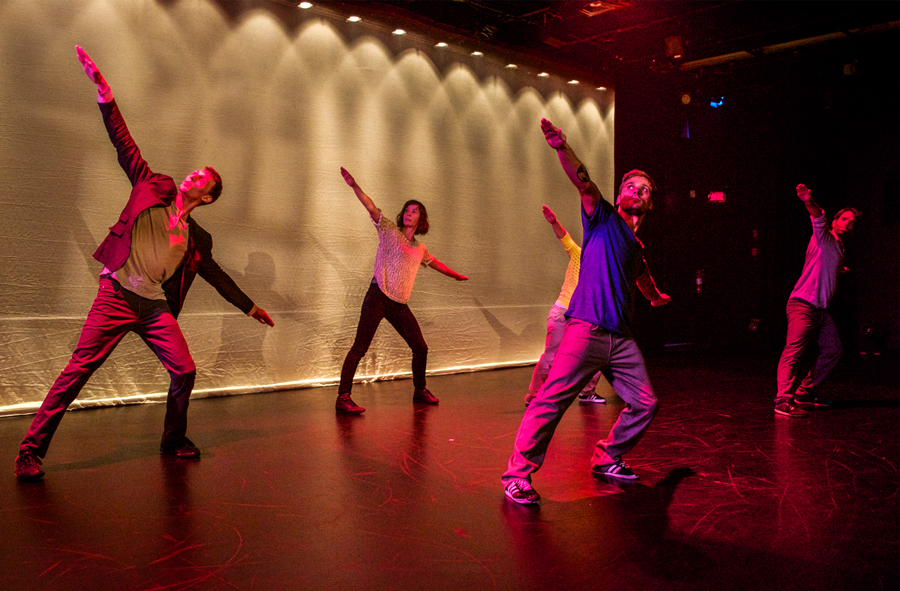If you’ve ever been on Montreal’s metro, you’ve probably heard the echo of the chiming bells before the automated voice comes on over the loudspeaker: “Attention, il y a une interruption de service sur la ligne verte…” This always triggers the unspoken question… was there a suicide? In a remounted version of his surreal piece “Loops,” which was originally performed in 2008, urban dance choreographer Ismaël Mouaraki plays on daily events such as rush hour, system failures, and suicides occurring in Montreal’s metro. The piece was inspired by, and created in, the metro itself.
After finishing off a series of performances at the Lincoln Center Institute in New York, “Loops” came to MAI (Montréal, arts interculturels) this past week, on September 19 and 20. The piece was imbued with striking originality and thematic depth. “Loops” featured five dancers (David Albert-Toth, Simon Ampleman, Geneviève Boulet, Jennifer Casimir, and Christian “Sancho” Garmatter) of diverse stylistic backgrounds, bringing together urban hip-hop with contemporary dance.
The piece began with two dancers performing repetitive popping and locking movements, mimicking the cyclical and monotonous structure of the metro system. Leaps, turns, and partnering work were then carefully melded in; elements of contemporary dance that brought a lifelike energy to the piece. On his unique blend of street dance and contemporary, Mouaraki says, “I always danced in the street. I practiced in the street; I learned in the street, I developed my moves, my dance technique, in the street. When we were dancing on the street in Paris, a contemporary choreographer came up and asked if we wanted to create a piece with him, and that’s where it all came from.” From that point onwards, he also learned contemporary dance and sought dancers of both styles to amalgamate the two in his choreographies. He believes that dancing in stimulating environments, such as outside on the street, provides a dancer with more energy to feed off of. This is why “Loops” was initially performed in the metro.
The dancing in “Loops” explores a wide range of emotions through a great variety of movements. The dancers seemed to play off of each other’s energy often, such as in one routine where they each took turns showing off their talents, being careful not to fall over while riding the ‘metro.’ Like the metro, Mouaraki’s choreography sped up and slowed down again. In one routine, the dancers acted as metro cars, swaying back and forth, as the music screeched to a halt to signal the opening of the doors. At times like these, “Loops” was lighthearted and fun – at other times, it became dark and intense. In one instance, the dancers went into a pop-and-lock routine depicting a metro suicide, an event which Mouaraki himself was once witness to. Their sharp, isolated movements emphasized the mechanical intonation of the “interruption de service” announcement that was incorporated into the music. The emotionless beginning of this suicide segment parallels many commuters’ real-life reaction, an automatic and methodical response to the tragic event of a suicide attempt in the metro.
This exploration of everyday life through dance is a recurring theme in Mouaraki’s work. His next show, to be performed in January, will employ the motif of a laundromat. Clothing, he says, is a metaphor for our identities. He intends to explore the idea that we protect ourselves, or show a certain version of ourselves with the clothes we wear. His aim is to examine how people of all kinds of backgrounds interact in public spaces, and how this shared experience influences the way people connect and affect each other in day-to-day life. This laundromat piece is another allegory for the perpetual message that Mouaraki wants to communicate to his audience. “Dance can influence daily routine in a positive way […] touching upon any and all social classes,” says Mouaraki.
Mouaraki’s innovations promise to continue to influence the Montreal dance scene. His mix of street and contemporary dance, along with his use of public spaces, makes Mouaraki’s work unique in the milieu. In “Loops,” he once again manages to get audiences to reflect on our shared experiences and the potential to connect with each other in everyday life with his brilliant choreography.

